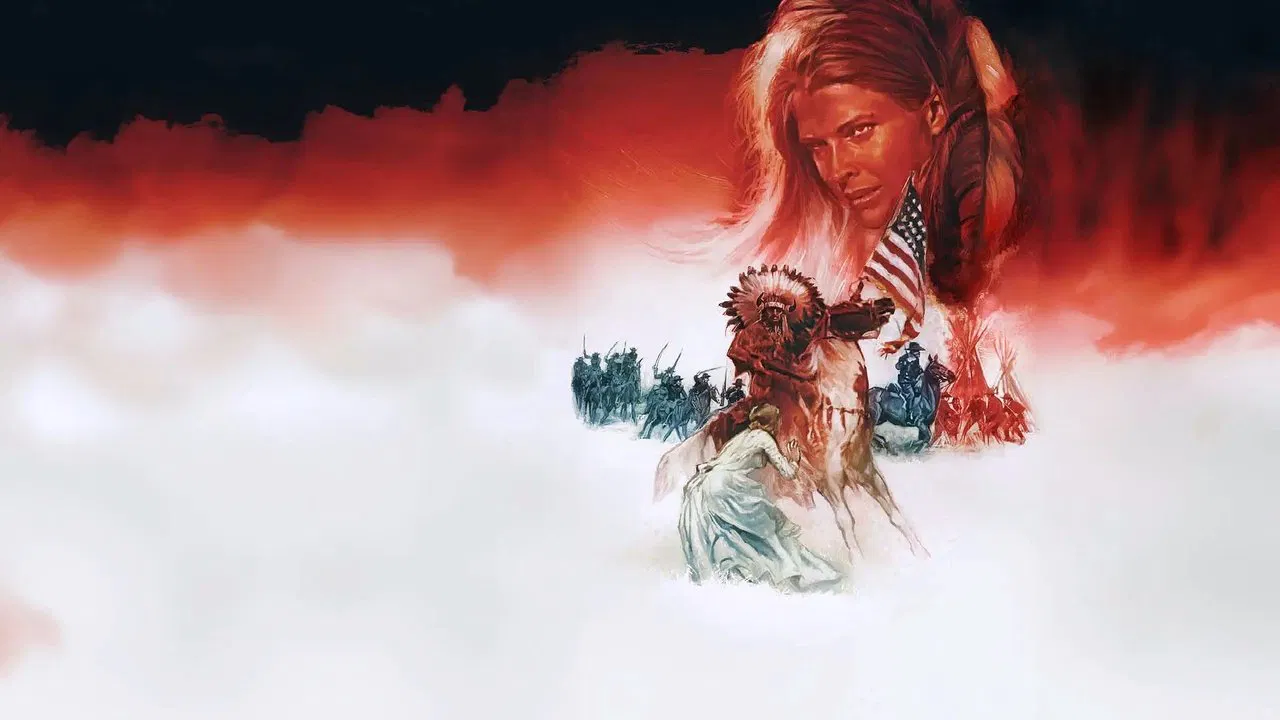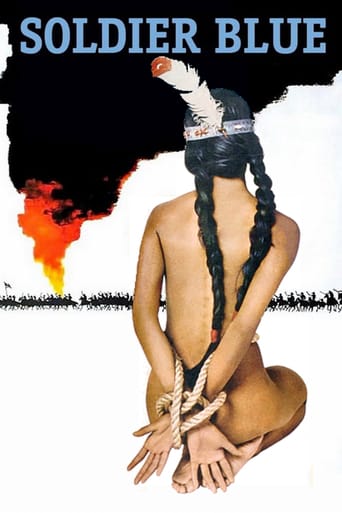

brilliant actors, brilliant editing
... View MoreThis is one of the few movies I've ever seen where the whole audience broke into spontaneous, loud applause a third of the way in.
... View MoreExactly the movie you think it is, but not the movie you want it to be.
... View MoreThe film never slows down or bores, plunging from one harrowing sequence to the next.
... View MoreReleased in 1970 and directed by Ralph Nelson, "Soldier Blue" is a Western starring Peter Strauss and Candice Bergen as a soldier and Native sympathizer, the only two survivors of a cavalry group Massacred by the Cheyenne. As they travel together to get back to the soldier's unit he struggles with his affection for the woman and a revulsion for her anti-US government outlook. Then he sees the awful truth.This controversial Western showcases the atrocities of the US Army against Native Americans wherein the average US Cavalry solder is depicted as a shifty, droop-eyed, unwashed, stupid cracker idiot with flies buzzing around his head. The opening Indian attack is set in order to align the audience's sympathies with Honus (Strauss, the 'Soldier Blue' of the title), so that the viewer travels on the same journey as him, starting by regarding the Indians as murderous barbarians, and ending up forced to confront the idea that maybe his kin are just as barbaric when the occasion is 'right' (or, should I say, wrong).The final massacre is shocking, but hampered by the film's insistence on stacking the deck so completely in terms of depicting the US military as savages dripping with ee-vil. In other words, it loses its impact because it's so overdone.In reality, utterly barbaric attacks applied to both uncivilized Natives and the civilized Europeans, but more so with the former, which is documented. Since the 60s-70s there has been an overemphasis on the injustices committed by the US Army or settlers and we get a handful of examples: Wounded Knee, Bear River and Sand Creek (the latter being what "Soldier Blue" is based on). Yet we never hear the other side of what caused these events nor do we hear of the atrocities of Natives committed against New Americans. For instance, we never hear of the Dakota "War" of 1862 (Santee Sioux went on the war path and murdered between 600-800 white settlers, which constituted the largest death toll inflicted upon American civilians by an enemy force until 9/11), The Ward Massacre, The Nez Perce uprising which killed dozens of settlers in Idaho and Wyoming, and the Massacre at Fort Mims. We never hear of the countless innocent settlers who were murdered by roaming bands of young "warriors": While a chief was signing a peace treaty on the tribe's behalf they were out robbing, raping and murdering.I'm just saying that it's easy to be pro-Native sitting on the comfort of your sofa, but not so much when you and your loved ones are threatened with torture & slaughter.The Europeans wanted the Native's land and resources while the Indians wanted the technology of the Europeans. Both sides used treaties to make peace while still trying to get what they wanted when war was too expensive. Both sides made war when they felt no other option.I love Native American culture, but the whitewashing of Native atrocities and this revisionist history stuff is dishonest and unbalanced. "Soldier Blue" is guilty of this but, as a movie, it's entertaining and its message is necessary in light of all the movies that depict Indians as sub-human savages to be gunned down on the spot.The film runs 114 minutes and was shot in Mexico.GRADE: B
... View MoreDon't want to write to much. I cant give this movie lower than 7 because it shows how the west was really won and it accuses the patriarchal Americans of today. But it had 0 entertaining potential. I tried to sympathize with the protagonist but i really couldn't. Also the plot was really slow at times and sometimes i was close to fall asleep. But like i said the ending was great and i don't have any point of criticism concerning the acting. After all it was a pretty good movie, that sometimes annoyed the **** out of me. I still recommend it for people that want to see some sad true stuff about American history. ( sorry for my bad English )
... View MoreSoldier Blue chronicles the adventures of Honus (Peter Strauss) and Cresta (Candice Bergen), the only survivors of a Cheyenne Indian attack, as they journey across the wilderness of the old west in search of refuge. Donald Pleasance has a memorable but all too brief role as an eerily sleazy gun runner who encounters the pair,( witness his enormous teeth!) 'Soldier Blue' encompasses A life changing journey that reaches a tragic climax as they bare witness to the cold-blooded slaughter of the Cheyenne tribe. Reflecting the political climate of the time, Soldier Blue is uncompromising in its anti-war stance and its extremely graphic and savage depiction of the Sand Creek Massacre of 1864. It is dated albeit slightly witness the all too bright red paint like blood! but remains an incredible allegory.
... View MoreFirst of all, this film can be divided into three segments. A promising opening, with the ambushing of some cavalry by the Cheyenne. This is followed by what can only be described as a long boring middle section, with the totally miscast Candice Bergen and "Soldier Blue" traveling together to reach the safety of an Army garrison. Miss Bergen spews forth inappropriate four letter words every time she opens her mouth, and looks like she just walked out of a 1970s Jack Nicholson movie. I mean she maintains zero interest, with zero believability. The third and final section involves the totally gratuitous slaughter of an Indian village. This is so obviously overdone to lay on the anti-war propaganda, that it comes across as simply long, outrageous, and contrived. Not recommended. - MERK................................ Jacobe (comment above) Here's an idea. Why don't you actually watch the movie you are commenting on, instead of chirping your liberal nonsense. This is not a political site, it is for reviewing films. - MERK
... View More